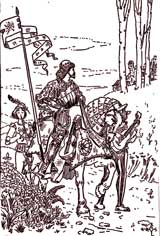The Troubadours, Trouvères, and the Art of Courtly Love
The troubadours (called trouvères in Northern France) appeared in Southern France as early as the 11th century. They belonged to the society gathered at several small courts, where women held the supreme place. It was at these courts that the rules of the art of courtly love were established, and the songs of the troubadours were the first expression of the ideals of this art. They created their works using the dialect of the South, the Langue d'Oc.

Troubadours on their travels
In Northern France, the trouvères composed their songs in the northern dialect (Langue d’Oïl), the foremost among them being Chrétien de Troyes. Although the ideas of love in the romances of Chrétien are those found in the lyrics of the troubadours, his genius transformed them, through elaborate poetry, into something peculiarly his own.
Love was, for the troubadours, an art to be practised rather than a passion to be felt. A lover’s main concern was to act in strict accord with the courtly love rules. It is no surprise that the literature inspired by such strictures was devoid of spontaneity and real feeling.
True, there is passion in the poetry of Bernart de Ventadorn, with whom Eleanor of Aquitaine was romantically involved before she became Queen of France. But the writings of many of the troubadours and trouvères after Ventadorn are characterized by artificiality and monotony of sentiment. Simply imitating their predecessors, the very emotional experiences of love became stereotyped.
The poetry of the troubadours was inspired by real and actual love affairs. Their lyrics present the concrete workings of the sentiment, creating the basis of the erotic philosophy of Chrétien de Troyes and Andreas Capellanus, with his De Amore. Their poems portray their emotional experiences, their relation and attitude toward the ladies whose favor they sought, and how their behavior was affected by passion.
The lady is represented as perfect, her attributes exaggerated because of her rank. In many cases, the troubadour was her lover, but also her subject. Her perfection is pictured in her physical beauty and her character. Her physical beauty was according to the medieval ideal: blond or golden hair, beautiful eyes, her body slender, and well formed. She is distinguished for her courtesy, kindness, refinement, and good sense. Her influence on others is always ennobling. Her goodness affects all who come near her, making them better. In respect to the lover, the lady occupies a position of exalted superiority. He becomes her vassal and submits absolutely to her will.
Indistinct in the background, the lady rarely appears as a personality in the poetry of the troubadours. She possesses every good quality, but unfortunately, the lover rarely experiences her kindness. To him she is cold, capricious, and domineering. Her rigor is unabated despite him complaining of her cruelty. This coldness of the lady is the keynote for the most part of the poetry of the period. Its origin was the instinctive hesitancy of the woman to yield too easily, but now it had become unnaturally exaggerated. It will become a convention in later erotic literature, the main motive of the love poetry in France in the next four centuries.
Although the troubadours were generally an aristocratic caste, nobility was not a requisite for the troubadour-lovers of Provence. Poetry was common meeting ground for knight and burgher, for kings and peasants.
The first troubadour whose work is extant is William IX, Duke of Aquitaine and Gascony and Count of Poitou (1071 – 1126). Besides his political and military achievements, he was a renowned poet writing in the Occitan language.
Pierre Vidal, one of the most prolific writers, was the son of a furrier. Alphonso II of Aragon (1157 – 25 April 1196), one of the great rulers of his age, like Richard the Lionheart, was not only the friend and patron of the troubadours, but a maker of verses himself.
Bernart de Ventadorn, who loved and was loved by Eleanor of Aquitaine, was of low degree. He was the son of a serving man, who gathered brushwood for the heating of the oven where the castle bread was baked.
All of these poets agreed to the ennobling effect of love on the character of the lover. Specifically, because of his love, he becomes courteous, gentle, humble, generous, and courageous.
All the troubadours and trouvères, when trying to emphasize the absolute devotion of the lover to the lady, made heavy use of their imagination in order to describe the symptoms of love, leading to physical and mental suffering: sickness, sleeplessness, the confusion and loss of speech in the lady's presence, together with trembling and pallor, and the fear of his feelings being detected by others.

